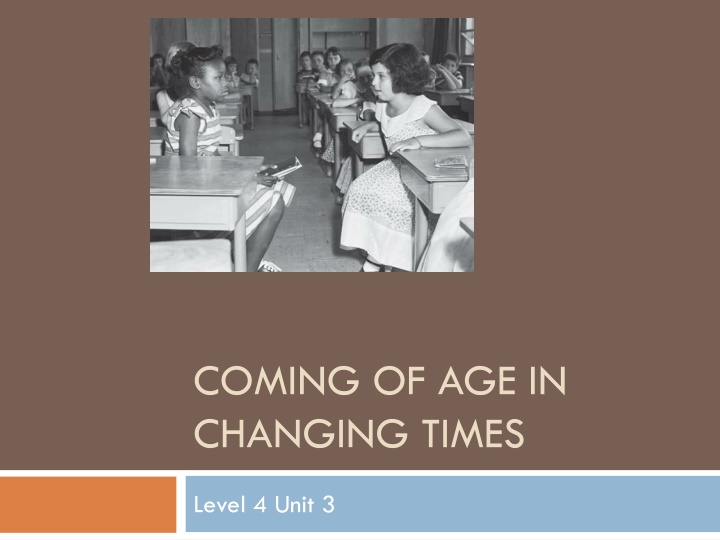Standing in Borrowed Shoes: Character Perspectives
In this literature unit, students delve into character analysis by exploring various perspectives in the novel "Coming of Age in Changing Times." They examine primary and secondary characters, their traits, interactions, and growth throughout the story. Through quickwrites, posters, and collaborative tasks, students gain insights into the complexities of flat and round characters, enhancing their understanding of thematic elements and character development.
Download Presentation

Please find below an Image/Link to download the presentation.
The content on the website is provided AS IS for your information and personal use only. It may not be sold, licensed, or shared on other websites without obtaining consent from the author.If you encounter any issues during the download, it is possible that the publisher has removed the file from their server.
You are allowed to download the files provided on this website for personal or commercial use, subject to the condition that they are used lawfully. All files are the property of their respective owners.
The content on the website is provided AS IS for your information and personal use only. It may not be sold, licensed, or shared on other websites without obtaining consent from the author.
E N D
Presentation Transcript
COMING OF AGE IN CHANGING TIMES Level 4 Unit 3
3.21 Standing in Borrowed Shoes Entry Task Quickwrite (RW NB) Consider the following quote from the novel: Atticus was right. One time he said you never really know a man until you stand in his shoes and walk around in them. Scout When have Scout, Jem, or Dill had to look at the world from other people s perspectives? What have they learned from other residents of Maycomb?
3.21 Standing in Borrowed Shoes Learning Targets Identify character traits and create a character profile poster collaboratively. Evaluate how primary and secondary characters and their interactions contribute to the development of a novel s themes.
3.21 Standing in Borrowed Shoes Literary Terms A flat or static character is uncomplicated, staying the same without changing or growing during the story. A round or dynamic character evolves and grows in the story and has a complex personality.
3.21 Standing in Borrowed Shoes Analyzing Characters (pg 241) 2. Work in a small group to list the primary (major) and secondary (minor) characters you can identify from the novel. Make notes on the thematic subjects that secondary characters might represent in the novel.
3.21 Standing in Borrowed Shoes Character Analysis Poster (242) 3. Working with a partner, create a character profile poster. Your poster should include the following elements: A picture or graphic representation of the character A physical description from the novel A list of several adjectives describing the character s personality, values, and/ or motives A description of the plot events in which this character is involved A quotation about him or her from another character A quotation by the character that reveals his or her values
3.21 Standing in Borrowed Shoes Gallery Walk (242) 4. As you view the posters your class creates, take notes in the graphic organizer below on at least two characters other than your own. You will need to work with a partner to complete all sections, finding textual evidence for support.
3.21 Standing in Borrowed Shoes Homework As you read Chapter 28, annotate each page with sticky notes. Pay close attention to the literary elements, and note how the tone shifts with different plot events.





















